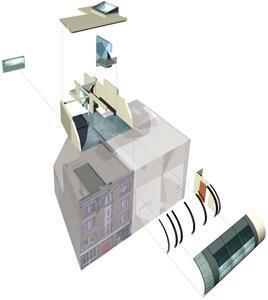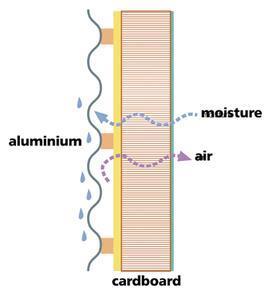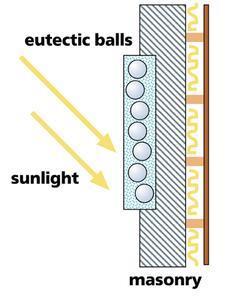From the street below, a curved polycarbonate facade will peep over the building's parapet wall, giving the extension a bubble-like appearance. The polycarbonate will act like a mirror, giving pedestrians a reflected view of the sky, "which is the reason the project got planning permission", explains Tom Barker, a director at B Consultants.
A steel structure beneath the flat's floor will transfer the weight of the extension to the building's party walls, and a T-shaped beam projecting upwards from the stairwell supports the weight of the roof. The result: there are no loadbearing walls, a fact Barker has exploited on the flat's rear elevation by using an aluminium-clad cardboard wall panel. Barker describes this as a "cheap and thermally efficient solution".
The cardboard wall is only one part of B Consultants' environmental strategy. Inside the flat, mounted on the chimneybreast, are three large tanks filled with eutectic balls. These will help keep the flat warm in winter and cool in summer. "It's an intelligently programmed storage heater," Barker says.
Construction is set to start in May, and the neighbours have given the proposal a mixed response. "Architects occupy the buildings each side," says Barker. "One wrote to the planning officer describing the extension as an exciting piece of avant-garde architecture, the other wrote saying it was vandalism."
Double-skin coated polycarbonate facade

This will transfer the weight of the roof directly to the stairwell to allow flexibility in the layout of internal partitions. Roof and skylight
A ventilated south-facing skylight will allow the sun to heat the eutectic balls in winter. Aluminium staircase
The staircase that links the extension to the flat is made of 15 mm thick plates of water-cut aluminium. These are slotted together using a mortise-and-tenon jointing system to form a free-standing structure. Rendered mansard walls built on existing party walls
The walls were originally designed to finish perpendicular to the roof, but after a meeting with the planning officer they were redesigned with a chamfered edge to be less obtrusive from the street.
Breathable cardboard wall

Eutectic tanks
























